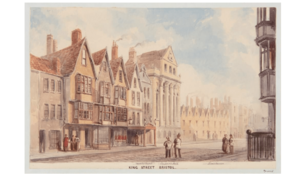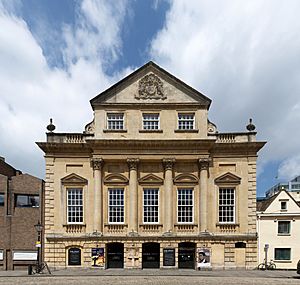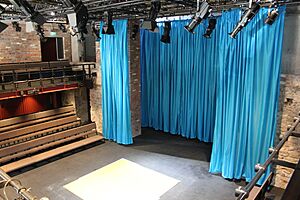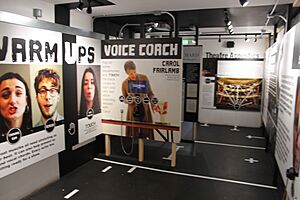Bristol Old Vic facts for kids

Old and new exterior in 2019
|
|
| Address | King Street BS1 4ED Bristol United Kingdom |
|---|---|
| Coordinates | 51°27′08″N 2°35′39″W / 51.4521°N 2.5942°W |
| Owner | Trustees of the Theatre Royal |
| Designation | Grade I listed building |
| Type | Repertory |
| Capacity | 540 (Theatre Royal) 188 (Weston Studio) |
| Construction | |
| Opened | 1766 |
| Rebuilt | 1970–72; 2016–18 |
| Website | |
| Bristol Old Vic | |
The Bristol Old Vic is a famous theatre company located at the Theatre Royal, Bristol. It's one of the most important theatres in the United Kingdom. The company started in 1946, growing from the well-known Old Vic theatre in London.
The Theatre Royal building is super old! It's the oldest theatre in the English-speaking world that has been open non-stop. It was built in Bristol between 1764 and 1766. A building called the Coopers' Hall, built even earlier in 1743–44, was later added to become the theatre's main entrance and lobby. Both buildings together are protected as a Grade I listed building, meaning they are very special and important. Even famous actor Daniel Day-Lewis once called it "the most beautiful theatre in England."
In 2012, the theatre finished a big upgrade. This made more seats available and created many flexible spaces for performances. The Bristol Old Vic also has a special Young Company for young people aged 7–25 who love theatre.
Contents
The Theatre's Long History
The theatre is on King Street, close to the Floating Harbour. For many years, people entered through the Coopers' Hall. This hall was built in 1744 for the Coopers' Company, a group of barrel makers in Bristol. It has a grand front with four columns. Over time, it was used for many things, like a wine warehouse and even a chapel, before becoming part of the theatre.
The theatre building itself was constructed between 1764 and 1766. Its design was similar to the Theatre Royal in London. To help pay for the building, 50 special silver tickets were sold. These tickets gave shareholders free entry to shows forever! Two extra special golden tickets were given to Edward Crump and his wife for helping to get permission to build the theatre.
The theatre officially opened on May 30, 1766, with a performance that included a special speech by David Garrick, a famous actor. At first, they couldn't get a special license, so they pretended their shows were "concerts with a bit of talking" to get around the rules!
In 1778, they finally got a Royal License and became a "Theatre Royal." They also started having shows in the winter. A group of actors began performing in both Bristol and the Bath Theatre Royal. Famous actress Sarah Siddons performed here, and some people say her ghost still visits the Bristol theatre! The main theatre area was updated in 1800.
Over the years, many people managed the theatre. It faced tough times in the late 1800s and early 1900s because of old buildings and changing entertainment. But in 1943, the London Old Vic theatre group stepped in to help save it.
You can find old documents about the Theatre Royal and Bristol Old Vic at Bristol Archives and the University of Bristol Theatre Collection.
How Bristol Old Vic Began
In 1942, the theatre building was put up for sale. People worried it might stop being a theatre. So, a public effort was made to save it, and a new group was formed to buy the building. In 1946, the Arts Council (a government group supporting arts) arranged for a company from the London Old Vic to run it. This is how the Bristol Old Vic was born!
Some very famous actors started their careers here, including Peter O'Toole, John Neville, Timothy West, and Dorothy Tutin. The first artistic director (the person in charge of the shows) was Hugh Hunt.
A big success for Bristol Old Vic was the musical Salad Days in 1954. It moved to London's West End and became the longest-running musical there at the time! The Arts Council helped until 1963. Then, the Bristol company became completely independent.
In 1972, a new part of the theatre complex was finished. The old entrance was replaced, and a new stage and technical areas were built. The Coopers' Hall became the grand entrance and lobby, giving the theatre a much-needed impressive front.
Through the 1970s and 1980s, Bristol Old Vic shows were very popular. Even though they faced money problems later, new leaders helped bring in more audiences and funding.
Big Renovations and Updates
In 2007, the theatre decided to close for major renovations. Some people worried about its future. But after many public meetings, a new team was put in charge, including Dick Penny and later Tom Morris as artistic director.
A huge fundraising effort began to raise £19 million for the updates. Many famous actors like Judi Dench and Patrick Stewart helped out. During the closure, the company still put on shows in other parts of the building and around Bristol.
The goal was to create a flexible theatre with up to ten different performance areas. The main theatre area got a new stage that can stick out into the audience, and more seats, bringing the total to 540. Other areas like the Side Stage and Paint Shop were also turned into performance spaces. The Theatre Royal re-opened in September 2012 with the play Wild Oats.
Even more updates happened between 2016 and 2018. The 1970s part of the building was changed to create a brand new foyer with a bar and box office. This new design shows off the old theatre walls that were hidden before. The Coopers' Hall was also updated to have new performance and event spaces, including a studio theatre in its basement.
Touring Shows
The Bristol Old Vic has a long history of taking its shows on tour, both around the United Kingdom and to other countries. For example, plays like Hamlet and A Man for All Seasons toured to places like Ceylon and Pakistan in the 1960s.
The company often performs at the Edinburgh Festival and other major theatres across the UK. They also work with other theatre companies to create and share plays. For instance, Tom Morris's production of Swallows and Amazons went on a big UK tour.
Engaging with Young People
The Bristol Old Vic has a special department that creates theatre opportunities for young people and others in Bristol and the South West. They run many workshops and work with schools, local communities, and charities.
A very important part of their work is the Young Company. This is one of the biggest youth theatres in the UK, with over 350 young people aged 5–25! They take part in weekly sessions, master classes, community projects, and perform full-scale shows. The Young Company puts on at least three shows every year.
The theatre also has a training program called Made in Bristol. This is a year-long course for about twelve young people aged 18–25. They become resident at Bristol Old Vic for two days a week, learning to be theatre-makers, workshop leaders, and facilitators. They create their own theatre company and perform a new play at the end of the year. Many of these groups continue to make theatre even after the course finishes!
Other projects include Firebird Theatre, a company of disabled artists, and partnerships with groups like Cardboard Citizens (working with homeless people) and Borderlands (welcoming refugees to the theatre).
Artistic Directors of Bristol Old Vic
| Name | Period | Notable productions | |
|---|---|---|---|
| Hugh Hunt | 1946–1949 | The Beaux' Stratagem, The Playboy of the Western World, An Inspector Calls, Romeo and Juliet | |
| Allan Davis | 1950 | Arms and the Man, Julius Caesar | |
| Denis Carey | 1950–1954 | The Merry Wives of Windsor, Macbeth, An Italian Straw Hat, The Alchemist | |
| John Moody | 1954–1959 | The Crucible, The Cherry Orchard, Uncle Vanya, The Recruiting Officer, As You Like It | |
| John Hale | 1959–1962 | The Clandestine Marriage, A Taste of Honey, Rhinoceros, Richard II | |
| Val May | 1962–1975 | Brand, The Killing of Sister George, Hamlet, The Italian Girl, Uncle Vanya | |
| Richard Cottrell | 1975–1980 | The National Health, Hedda Gabler, As You Like It, A Doll's House, A Midsummer Night's Dream | |
| John David | 1980–1986 | Judy, King Lear, Wild Oats, Arturo Ui, The Tempest | |
| Leon Rubin | 1986–1987 | The Doctor's Dilemma | |
| Paul Unwin | 1987–1991 | The Man Who Had All the Luck, Hamlet, The Master Builder | |
| Andy Hay | 1991–2002 | Blue Remembered Hills, The Duchess of Malfi, The Hairy Ape, The Rise and Fall of Little Voice, Marat/Sade, A Streetcar Named Desire | |
| David Farr and Simon Reade | 2003–2005 | Loot (Farr), The Odyssey (Farr), Private Peaceful (Reade) | |
| Simon Reade | 2005–2007 | The Birthday Party | |
| Tom Morris | 2009–2022 | Juliet and her Romeo, Swallows and Amazons, and The Crucible | |
| Nancy Medina | 2023- |
Bristol Old Vic Theatre School
The Bristol Old Vic Theatre School is a special school for people who want to work in theatre, film, and TV. It was opened by the famous actor Laurence Olivier in 1946, just after the theatre company started.
The school began in a small room above a warehouse. In 1954, money from the successful musical Salad Days helped the school buy and convert two large houses in Clifton, which are still their home today.
The school teaches students to be actors, directors, set designers, costume designers, lighting designers, and stage managers. Its graduates work all over the world! Some of the most famous actors who studied here include Academy Award winners Daniel Day-Lewis and Jeremy Irons.
You can see more alumni here: Alumni of Bristol Old Vic Theatre School.
Peter O'Toole Prize
When the theatre re-opened in 2012, they started an award called the Patron's Prize. It was later renamed the Peter O’Toole prize after the actor passed away. This award gives two graduating actors from the Bristol Old Vic Theatre School a six-month contract to work at the Bristol Old Vic. The first winners were Emily May Smith and Isaac Stanmore.
| Year | Recipients | Productions |
|---|---|---|
| 2012 | Emily May Smith and Isaac Stanmore | Wild Oats, Does My Society Look Big in This? and Peter Pan |
| 2013 | Martin Bassindale and Lindsay Dukes | Great Expectations and The Little Mermaid |
| 2014 | Jonathan Charles | Juno and the Paycock |
| Bethan Nash and Millie Corser | Swallows and Amazons |
See also
- Culture in Bristol






